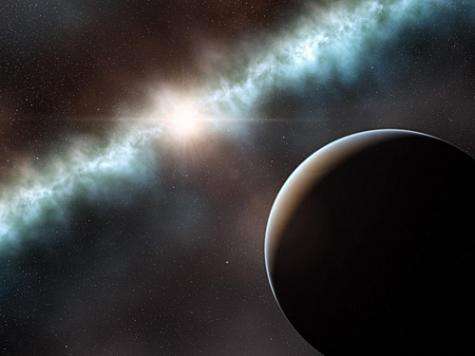Birth of a baby planet

(PhysOrg.com) -- University of Sydney astronomer, Professor Peter Tuthill, is one of an international team of astronomers who have announced a major step forward in the quest to find planets in orbit around distant stars. The discovery has been published in the international journal Astronomy and Astrophysics.
The team believe this to be the first image of a solar system caught in the act of formation.
Professor Tuthill said modern scientific ideas describing the way planets are expected to form can be traced to the 1700s.
"The philosopher Immanuel Kant proposed that they grow within a vast spinning pancake of dust which is the messy remnant leftover from the formation of the sun or star at the middle.
"Following a sort of snowball runaway effect, orbiting debris in the disk is expected to clump up into ever larger pieces until one becomes massive enough to draw in all the matter from the vicinity of its orbit. At this point, the fledgling planet will have cleared a gap or ring in the disk."
Although a number of such gaps have been found by astronomers, Kant's theory linking them to planets has remained in the realm of unproved phenomena, until now.
This first planetary baby-snap published by the team have caught a tiny fleck of light, betraying the presence of a massive body like a planet or possibly a brown dwarf, orbiting exactly on queue within the vacant gap in the disk surrounding the star T Chamaeleontis.
"For understanding planetary formation, this marks a major milestone," said Nuria Huélamo of Spain's Centro de Astrobiología, first author of the work to be published in the journal Astronomy and Astrophysics this month.
"This could be the first time we have been able to witness a companion digging a gap inside its protoplanetary disc."
"In addition to the exciting science, this result also represents a technical tour-de-force," adds Professor Tuthill whose team designed the instrument which recovered the images.
"You have got to work very hard to see that faint mote of light against the overwhelming glare when the telescope is staring almost directly at a bright star like T Chamaeleontis."
The quest to image planetary newborns has been one of the most sought-after goals in modern astronomy, and needed the power of the giant telescopes at the European Southern Observatory's Paranal observatory in Northern Chile.
"As with biology, studying newborns teaches us a lot," says Dr Michael Ireland, also on the Sydney team.
"We get to see their initial properties before they get scrambled up and influenced by their environment. However there is a practical reason too: a young planet is basically a searing ball of hot lava, and glows quite brightly making it much easier to detect compared to mature cool planets like those in our solar system."
Summing up the significance of the work, team member Dr Sylvestre Lacour of Paris Observatory said, "This result has opened a whole new window on our universe, let's just hope that through it we get to see many more newborn planets twinkling in the gaps they have sculpted."
More information: www.aanda.org/
Provided by University of Sydney

















